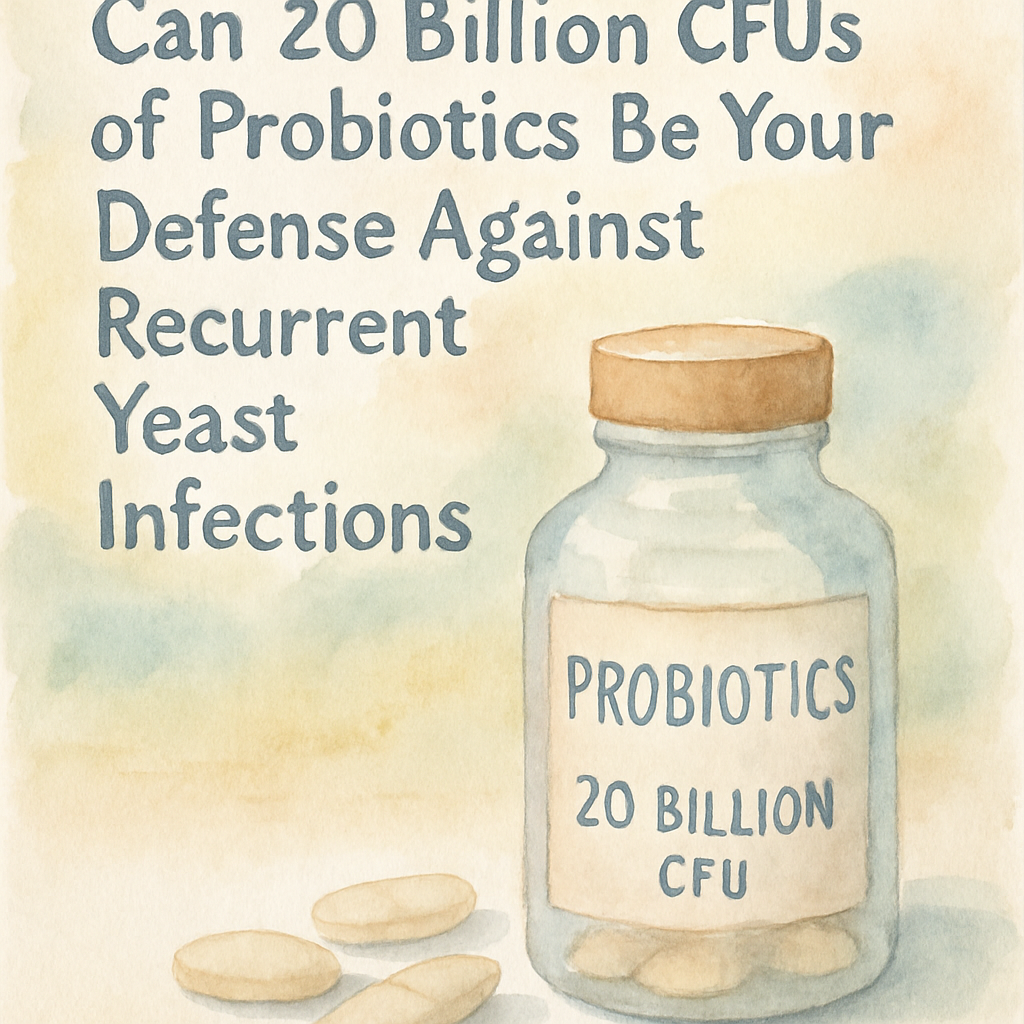it’s Emily here.
Vulvovaginal Candidiasis (VVC), commonly known as a yeast infection, is a familiar and frustrating affliction for millions of women, particularly in the US and UK. While standard antifungal treatments are effective for acute episodes, the high rate of recurrence, often affecting 50-75% of women at least once and a significant portion repeatedly (known as RVVC, or Recurrent VVC), drives a continuous search for reliable preventive strategies. The emerging star in this preventative care lineup? High-dose, multi-strain probiotics.
For years, probiotics have been suggested as a complementary therapy, aiming to restore a healthy vaginal microbiome dominated by protective Lactobacillus species. However, a major question for consumers and clinicians alike has been: How much is enough, and which strains matter? Recent research has shed light on the importance of both the specific strains and the total concentration, particularly focusing on products with high Colony-Forming Units (CFUs)—often reaching or exceeding $20$ Billion CFUs.
The Science Behind High-Dose Probiotics
The core mechanism is simple: Candida albicans, the primary culprit in VVC, thrives when the protective natural bacteria—mainly Lactobacillus species—are compromised. A healthy vaginal environment is acidic (low pH), largely thanks to the lactic acid produced by these beneficial bacteria. Probiotics aim to re-establish this “colonization resistance” (Source: Probiotics in the Management of Vulvovaginal Candidosis, MDPI, 2024).
The latest scientific literature, including comprehensive reviews and meta-analyses, increasingly points to several key factors that determine a probiotic’s effectiveness against VVC:
1. The “Billion-Dollar” Question: CFU Count:
While many studies on probiotics for vaginal health have successfully used concentrations greater than $10^9$ CFU (1 Billion CFU), the market trend and anecdotal clinical success often align with higher doses, such as $20$ Billion CFUs or more. The rationale is to ensure enough viable organisms survive the gastric transit (if taken orally) or provide a sufficient concentration for vaginal colonization.
- A 2024 review published in MDPI noted that the preferred concentration in various clinical studies investigating VVC management was “mostly $>10^9$ CFU” (Source: Probiotics in the Management of Vulvovaginal Candidosis, MDPI, 2024). The move to higher doses like $20$ Billion CFUs in commercial products reflects a push to maximize the chance of successful colonization, even though specific head-to-head trials comparing $1$B vs. $20$B CFUs for RVVC prevention are still needed to provide definitive evidence.
2. Strain Specificity: Not All Probiotics are Equal:
The effectiveness is highly strain-dependent, a point consistently highlighted across American and international research. Strains must possess specific antagonistic activities against Candida.
Key strains with documented evidence against Candida albicans adhesion and growth include:
- Lactobacillus rhamnosus GR-1
- Lactobacillus fermentum RC-14
- Lactobacillus acidophilus (specific strains like LA-5, LA02)
For instance, a review on RVVC prevention noted support for strains like L. rhamnosus GR-1 and L. fermentum RC-14, administered either orally or intravaginally, in colonizing the vagina and preventing infection (Source: Probiotics for prevention of recurrent vulvovaginal candidiasis: a review, J Antimicrob Chemother, 2006/2025 updates). Furthermore, recent in vitro studies emphasize that certain Lactobacillus strains demonstrate “strong antifungal activity” in a pH-dependent manner, validating the search for high-performing strains (Source: Lactobacillus rhamnosus strains of oral and vaginal origin show strong antifungal activity in vitro, PMC/NIH, 2020).
3. Synergistic Effects of Multi-Strain Formulas:
The latest approach favors multi-strain formulas over single-strain products. Researchers have confirmed that multi-strain probiotics often “exhibit greater efficacy in promoting host health and inhibiting pathogenic bacteria due to synergistic and additive effects among the strains” (Source: Synergistic Inhibition of Candida albicans by Cranberry Proanthocyanidins and Probiotics, MDPI, 2024).
A high-CFU product (e.g., $20$ Billion CFUs) that combines several well-studied Lactobacillus and possibly Bifidobacterium strains may offer a more robust defensive barrier against Candida overgrowth than a single-strain, lower-dose product. This is often the logic behind the composition of modern preventative probiotic supplements targeting women’s health.
Moving Beyond Antifungals: The Preventative Power
For women with Recurrent VVC, the focus shifts from treatment to prevention. While traditional antifungals remain the gold standard for acute treatment, probiotics are emerging as a safe, low-risk adjunctive therapy—meaning they are used alongside or after initial treatment to prevent the yeast from returning.
A 2025 study evaluating a vaginal probiotic suggested that probiotic treatments could “potentially enhance patient compliance and quality of life by reducing adverse reactions and recurrence rates” compared to miconazole (Source: Probiotics for prevention of recurrent vulvovaginal candidiasis: A review, ResearchGate, 2025). The safety and tolerability of probiotics are consistently reported across the research, affirming their role as a low-risk intervention for prevention (Source: Probiotics in the Management of Vulvovaginal Candidosis, MDPI, 2024).
The Caveat and Future Directions
Despite the promising evidence, the medical community maintains a cautious stance. The UK’s NHS notes that while some evidence suggests probiotics may be helpful for certain conditions, the products are often regulated as food, not medicine. This means quality and efficacy can vary widely, and consumers must be mindful of whether the product “contains enough bacteria to have an effect” (Source: Probiotics, NHS, 2025). The high CFU count in products like the $20$ Billion CFU formulas is often a manufacturer’s strategy to address this survival and efficacy challenge.
Future US and international research will continue to focus on:
- Defining the Optimal Dosage: Pinpointing the exact minimum and maximum effective CFU count (e.g., is $20$B significantly better than $10$B?) for RVVC prevention in large-scale Randomized Controlled Trials (RCTs).
- Delivery Method: Further clarifying the comparative efficacy of oral versus vaginal administration, particularly during pregnancy and for long-term prevention (Source: Oral Probiotics to Prevent Recurrent Vulvovaginal Infections During Pregnancy, MDPI, 2025).
- Strain Identification: Continually isolating and testing novel, high-adherence, and high-antifungal Lactobacillus strains.
For Preventative Care
For readers seeking a proactive defense against the recurrence of VVC, the latest research supports the use of high-quality probiotic supplements. A product featuring specific, clinically-studied Lactobacillus strains (like GR-1 or RC-14) in a high-concentration formula ($20$ Billion CFU or more) aligns with the emerging scientific consensus on maximizing colonization and antagonistic activity against Candida.
While probiotics should be viewed as a complementary approach rather than a replacement for prescribed antifungal therapy, the evidence is strong enough to position them as a valuable, low-risk tool in the modern preventative care regimen for vulvovaginal health. As always, consult with a healthcare professional before starting any new supplement to ensure it is appropriate for your individual health needs.



